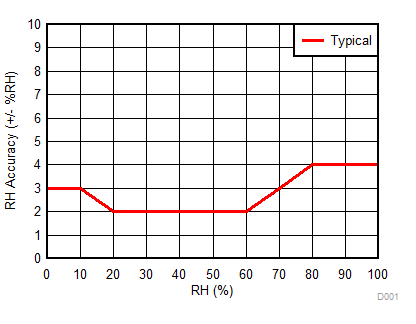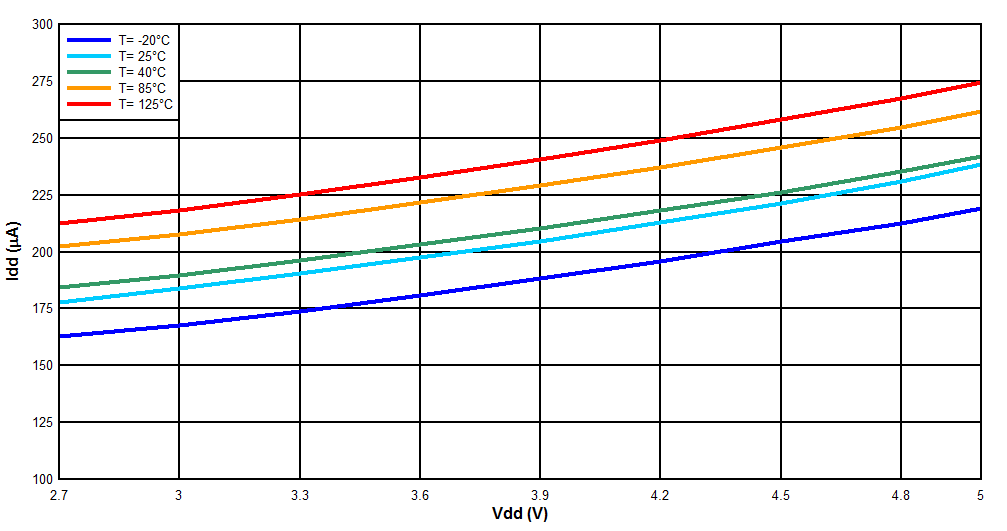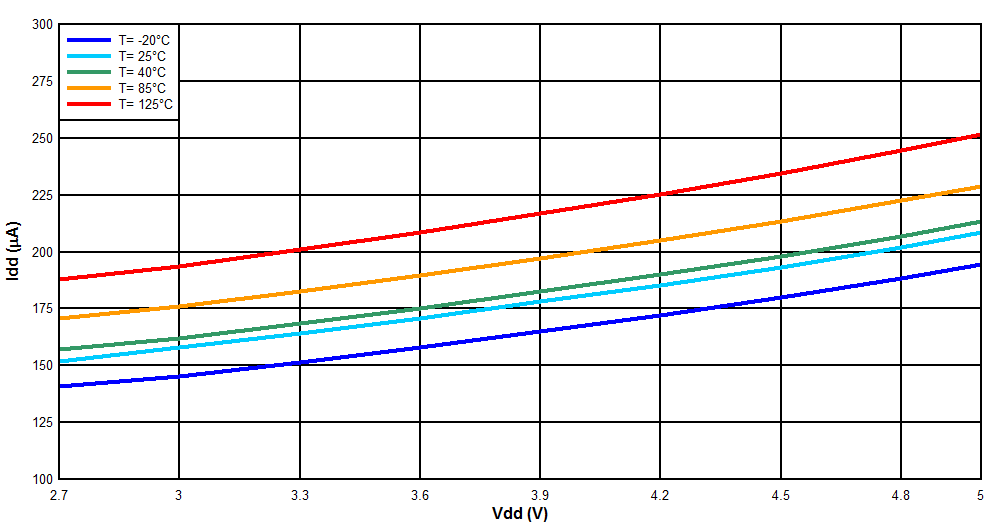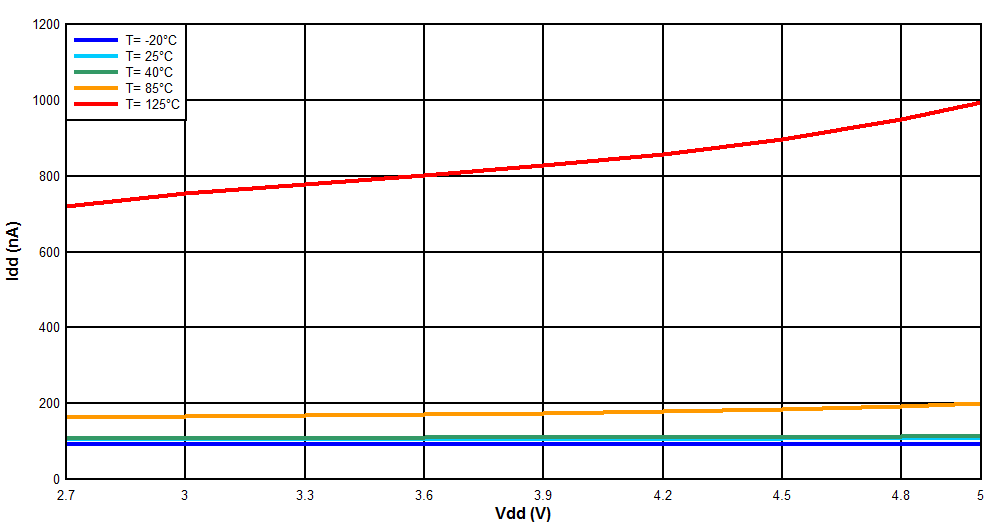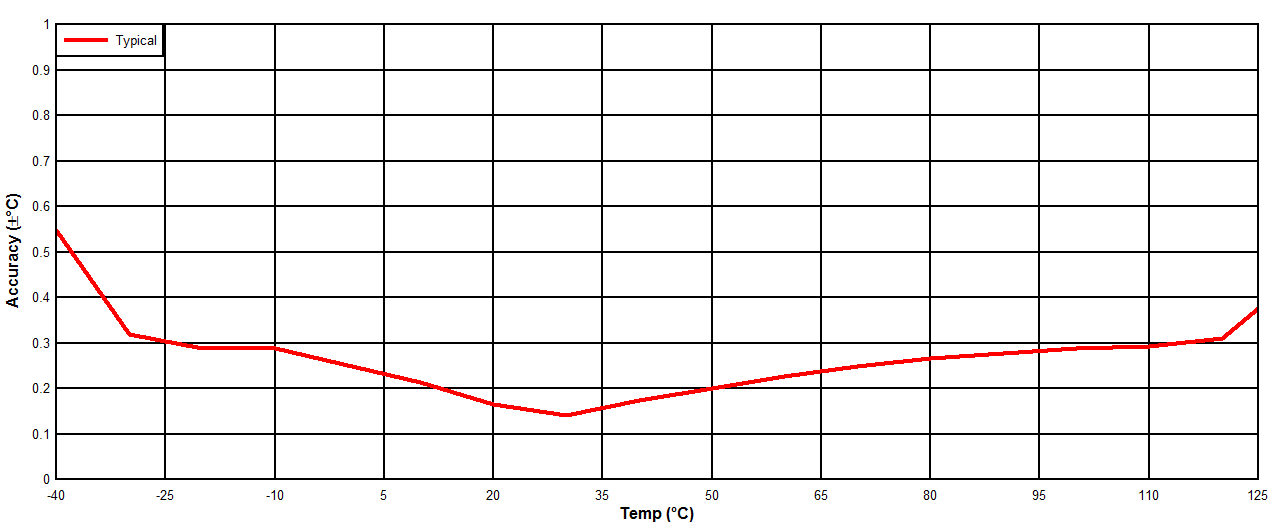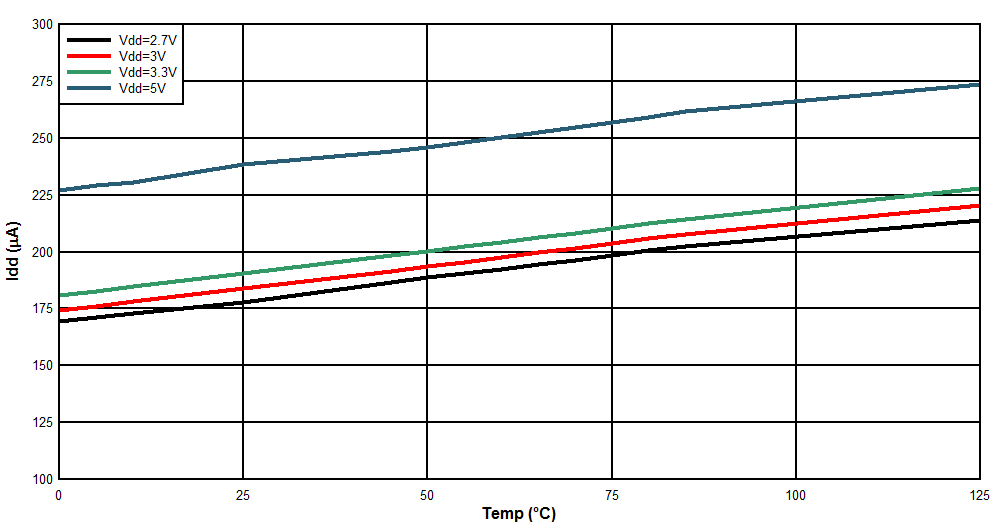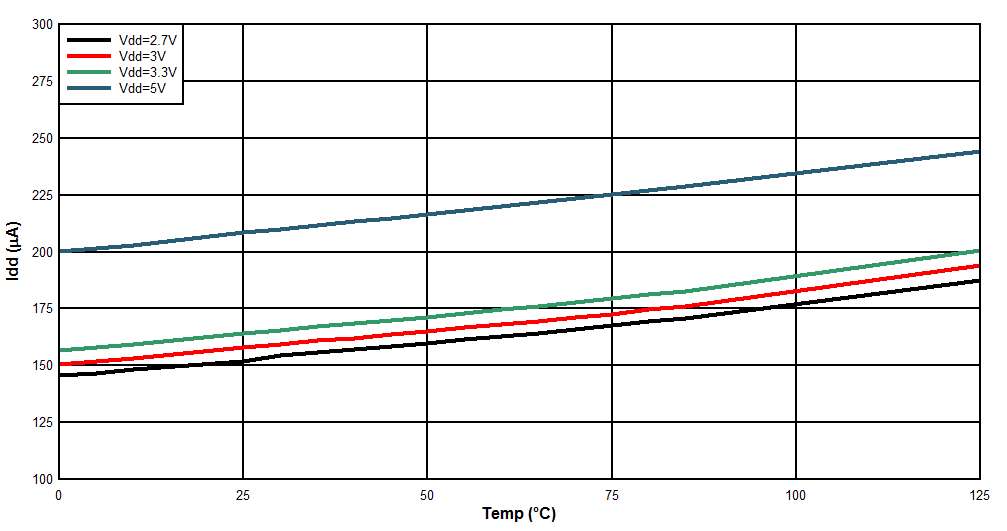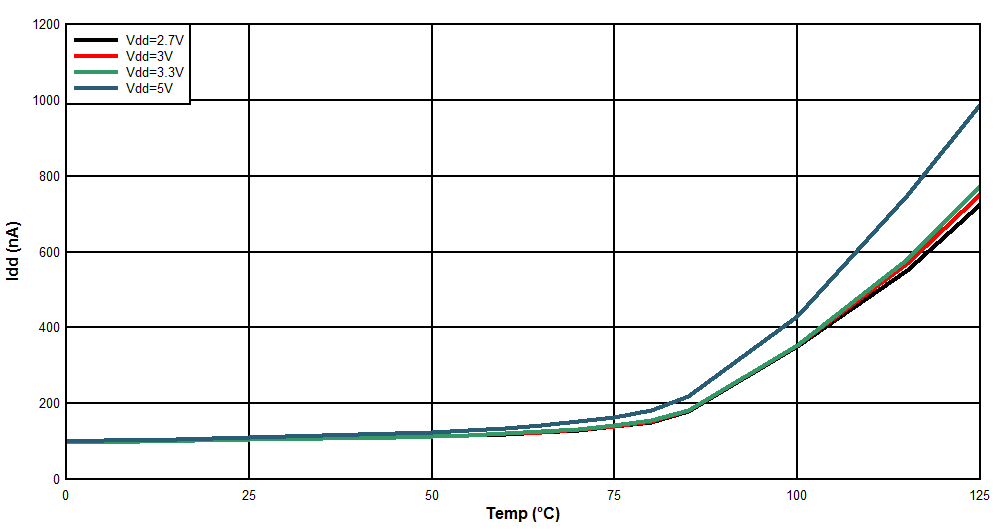SNAS672A November 2015 – January 2016 HDC1080
PRODUCTION DATA.
- 1 Features
- 2 Applications
- 3 Description
- 4 Revision History
- 5 Pin Configuration and Functions
- 6 Specifications
- 7 Detailed Description
- 8 Application and Implementation
- 9 Power Supply Recommendations
- 10Layout
- 11Device and Documentation Support
- 12Mechanical, Packaging, and Orderable Information
パッケージ・オプション
メカニカル・データ(パッケージ|ピン)
- DMB|6
サーマルパッド・メカニカル・データ
- DMB|6
発注情報
6 Specifications
6.1 Absolute Maximum Ratings(1)
| MIN | MAX | UNIT | ||
|---|---|---|---|---|
| Input Voltage | VDD | -0.3 | 6 | V |
| SCL | -0.3 | 6 | ||
| SDA | -0.3 | 6 | ||
| Storage Temperature | TSTG | -65 | 150 | °C |
(1) Stresses beyond those listed under Absolute Maximum Ratings may cause permanent damage to the device. These are stress ratings only, which do not imply functional operation of the device at these or any other conditions beyond those indicated under Recommended Operating Conditions. Exposure to absolute-maximum-rated conditions for extended periods may affect device reliability.
6.2 ESD Ratings
| VALUE | UNIT | |||
|---|---|---|---|---|
| V(ESD) | Electrostatic discharge | Human-body model (HBM), per ANSI/ESDA/JEDEC JS-001(1) | ±2000 | V |
| Charged-device model (CDM), per JEDEC specification JESD22-C101(2) | ±500 | |||
(1) JEDEC document JEP155 states that 500-V HBM allows safe manufacturing with a standard ESD control process.
(2) JEDEC document JEP157 states that 250-V CDM allows safe manufacturing with a standard ESD control process.
6.3 Recommended Operating Conditions
over operating range (unless otherwise noted)| MIN | NOM | MAX | UNIT | ||
|---|---|---|---|---|---|
| VDD | Supply Voltage | 2.7 | 3 | 5.5 | V |
| TA, Temperature sensor | Ambient Operating Temperature | -40 | 125 | °C | |
| TA, Humidity sensor(1) | Ambient Operating Temperature | -20 | 70 | °C | |
| TA, Humidity sensor(1) | Functional Operating Temperature | -20 | 85 | °C | |
(1) See Figure 2.
6.4 Thermal Information
| THERMAL METRIC(1) | HDC1080 | UNIT | |
|---|---|---|---|
| PWSON (DMB) | |||
| 6 PINS | |||
| RθJA | Junction-to-ambient thermal resistance | 49.4 | °C/W |
| RθJC(top) | Junction-to-case (top) thermal resistance | 29.8 | °C/W |
| RθJB | Junction-to-board thermal resistance | 23.1 | °C/W |
| ψJT | Junction-to-top characterization parameter | 3.3 | °C/W |
| ψJB | Junction-to-board characterization parameter | 23.1 | °C/W |
| RθJC(bot) | Junction-to-case (bottom) thermal resistance | 4.2 | °C/W |
(1) For more information about traditional and new thermal metrics, see the Semiconductor and IC Package Thermal Metrics application report, SPRA953.
6.5 Electrical Characteristics(1)
The electrical ratings specified in this section apply to all specifications in this document, unless otherwise noted. TA = 30°C, RH = 40%, and VDD = 3V.| PARAMETER | TEST CONDITION(2) | MIN(3) | TYP(4) | MAX(3) | UNIT | |
|---|---|---|---|---|---|---|
| POWER CONSUMPTION | ||||||
| IDD | Supply Current | RH measurement, bit 12 of 0x02 register = 0(10) | 190 | 220 | µA | |
| Temperature measurement, bit 12 of 0x02 register = 0(10) | 160 | 185 | µA | |||
| Sleep Mode | 100 | 200 | nA | |||
| Average @ 1 measurement/second, RH (11 bit), bit 12 of 0x02 register = 0(10)(11) | 710 | nA | ||||
| Average @ 1 measurement/second, Temp (11 bit), bit 12 of 0x02 register = 0(10)(11) | 590 | nA | ||||
| Average @ 1 measurement/second, RH (11bit) +temperature (11 bit), bit 12 of 0x02 register = 1(10)(11) | 1.3 | µA | ||||
| Startup (average on Start-up time) | 300 | µA | ||||
| IHEAT | Heater Current(5) | Peak current | 7.2 | mA | ||
| Average @ 1 measurement/second, RH (11bit) +temperature (11 bit), bit 12 of 0x02 register = 1(10)(11) | 50 | µA | ||||
| RELATIVE HUMIDITY SENSOR | ||||||
| RHACC | Accuracy | Refer to Figure 2 in Typical Characteristics section. | ±2 | %RH | ||
| RHREP | Repeatability(5) | 14 bit resolution | ±0.1 | %RH | ||
| RHHYS | Hysteresis (7) | 10% ≤ RH ≤ 70% | ±1 | %RH | ||
| RHRT | Response Time(9) | t 63% (8) | 15 | s | ||
| RHCT | Conversion Time(5) | 8 bit resolution | 2.50 | ms | ||
| 11 bit resolution | 3.85 | ms | ||||
| 14 bit resolution | 6.50 | ms | ||||
| RHOR | Operating Range(6) | Non-condensing | 0 | 100 | %RH | |
| RHLTD | Long Term Drift(12) | ±0.25 | %RH/yr | |||
| TEMPERATURE SENSOR | ||||||
| TEMPACC | Accuracy(5) | 5°C < TA< 60°C | ±0.2 | ±0.4 | °C | |
| TEMPREP | Repeatability(5) | 14 bit resolution | ±0.1 | °C | ||
| TEMPCT | Conversion Time(5) | 11 bit accuracy | 3.65 | ms | ||
| 14 bit accuracy | 6.35 | ms | ||||
(1) Electrical Characteristics Table values apply only for factory testing conditions at the temperature indicated. Factory testing conditions result in very limited self-heating of the device such that TJ = TA. No guarantee of parametric performance is indicated in the electrical tables under conditions of internal self-heating where TJ > TA. Absolute Maximum Ratings indicate junction temperature limits beyond which the device may be permanently degraded, either mechanically or electrically.
(2) Register values are represented as either binary (b is the prefix to the digits), or hexadecimal (0x is the prefix to the digits). Decimal values have no prefix.
(3) Limits are ensured by testing, design, or statistical analysis at 30°C. Limits over the operating temperature range are ensured through correlations using statistical quality control (SQC) method.
(4) Typical values represent the most likely parametric norm as determined at the time of characterization. Actual typical values may vary over time and will also depend on the application and configuration. The typical values are not tested and are not guaranteed on shipped production material.
(5) This parameter is specified by design and/or characterization and it is not tested in production.
(6) Recommended humidity operating range is 10% to 70% RH. Prolonged operation outside this range may result in a measurement offset. The measurement offset will decrease after operating the sensor in this recommended operating range.
(7) The hysteresis value is the difference between an RH measurement in a rising and falling RH environment, at a specific RH point.
(8) Time for the RH output to change by 63% of the total RH change after a step change in environmental humidity.
(9) Actual response times will vary dependent on system thermal mass and air-flow.
(10) I2C read/write communication and pull-up resistors current through SCL and SDA not included.
(11) Average current consumption while conversion is in progress.
(12) Drift due to aging effects at typical conditions (30°C and 20% to 50% RH). This value may be impacted by dust, vaporized solvents, out-gassing tapes, adhesives, packaging materials, etc.
6.6 I2C Interface Electrical Characteristics
At TA=30°C, VDD=3V (unless otherwise noted)| PARAMETER | TEST CONDITION | MIN | TYP | MAX | UNIT | |
|---|---|---|---|---|---|---|
| I2C INTERFACE VOLTAGE LEVEL | ||||||
| VIH | Input High Voltage | 0.7xVDD | V | |||
| VIL | Input Low Voltage | 0.3xVDD | V | |||
| VOL | Output Low Voltage | Sink current 3mA | 0.4 | V | ||
| HYS | Hysteresis (1) | 0.1xVDD | V | |||
| CIN | Input Capacitance on all digital pins | 0.5 | pF | |||
(1) This parameter is specified by design and/or characterization and it is not tested in production.
6.7 I2C Interface Timing Requirements
| PARAMETER | TEST CONDITION | MIN | NOM | MAX | UNIT | |
|---|---|---|---|---|---|---|
| I2C INTERFACE VOLTAGE LEVEL | ||||||
| fSCL | Clock Frequency | 10 | 400 | kHz | ||
| tLOW | Clock Low Time | 1.3 | µs | |||
| tHIGH | Clock High Time | 0.6 | µs | |||
| tSP | Pulse width of spikes that must be suppressed by the input filter (1) | 50 | ns | |||
| tSTART | Device Start-up time | From VDD ≥ 2.7 V to ready for a conversion(1)(2) | 10 | 15 | ms | |
(1) This parameter is specified by design and/or characterization and it is not tested in production.
(2) Within this interval it is not possible to communicate to the device.
 Figure 1. I2C Timing
Figure 1. I2C Timing
6.8 Typical Characteristics
Unless otherwise noted. TA = 30°C, VDD = 3V.